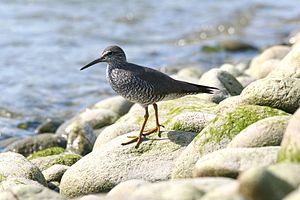Wandering water strider
| Wandering water strider | ||||||||
|---|---|---|---|---|---|---|---|---|

Wandering water strider ( Tringa incanus ) |
||||||||
| Systematics | ||||||||
|
||||||||
| Scientific name | ||||||||
| Tringa incanus | ||||||||
| ( Gmelin , 1789) |
The water strider ( Tringa incanus , Syn . : Heteroscelus incanus ) is a monotypical species from the family of the snipe bird. The species occurs exclusively in the Nearctic . The IUCN classifies the water strider as not endangered ( least concern ).
Appearance
The wandering water strider reaches a body length of 26 to 30 centimeters and is thus somewhat larger than the closely related gray-tailed water strider , which is common in the Palearctic . The wing span of the sandpiper is 55 to 70 centimeters. The weight varies between 90 and 125 grams.
In its splendid dress , the sandpiper has a slate-gray top of the head, neck and a slate-gray top of the body. Individual feathers have a white tip, so that the top of the body has small white spots. A white stripe of the eyes runs from the forehead over the eyes to the back of the head, underneath is a darker stripe that runs from the base of the beak over the eyes. The dark circles are white and emphasized by the dark eye stripe. The beak is dark gray with a yellow-gray beak base. The eyes are dark. The cheeks, chin, throat and underside of the body are white with a very dense, dark gray transverse wave. Most individuals have a white, unmarked spot on their stomach. The legs are relatively strong in relation to the body and are bright yellow to yellow-greenish. In the simple dress , the transverse corrugation is missing on the chest and the flanks, these are then slate gray. Young birds are similar to the adult birds in the plain dress, but have a hint of gray cross-markings on the chest and the flanks as well as white feather tips on the upper wing coverts.
Distribution area
Compared to the gray-tailed water strider, the wandering water strider has a relatively small breeding area. It breeds exclusively in Alaska and the adjacent Yukon Territory , but is rare in the entire range. As a habitat, it prefers the gravel banks of rivers or rocky coasts. It is a mandatory migratory bird that migrates to the southwest coast of the United States during the winter months. It then occurs in Hawaii as well as some more remote Pacific islands. Its habitat during the winter months are rocky coasts.
Way of life
The sandpiper eats invertebrates, with insects and their larvae playing a particularly important role. It also eats mollusks and worms. He picks his food from the surface of the water or finds it by poking in the moist substrate or in the shallow water zone.
The water strider lives sociable during the winter months. In the breeding areas, however, the males occupied breeding grounds, from which they drive the other males. Wandering water striders enter into a monogamous seasonal marriage. The nest is built on the ground near water. It's just a shallow hollow that is lined with some plant material. The clutch consists of three to four eggs. These are pale green or olive and brown speckled and speckled. The breeding season is 23 to 25 days. Both parent birds are involved in the brood. The chicks flee the nest and are led by both parent birds. They can fledge between 18 and 21 days.
Wandering water striders breed for the first time in their second year of life at the earliest.
supporting documents
literature
- Richard Sale: A Complete Guide to Arctic Wildlife. Christopher Helm, London 2006, ISBN 0-7136-7039-8 .
